technical specifications Lancia Ypsilon 2015 Owner handbook (in English)
[x] Cancel search | Manufacturer: LANCIA, Model Year: 2015, Model line: Ypsilon, Model: Lancia Ypsilon 2015Pages: 315, PDF Size: 10.85 MB
Page 106 of 315

"ENERGY SAVING" FUNCTION
(for versions/markets, where provided)
If, following automatic engine restarting, the
driver does not carry out any action on the car for
over 3 minutes, the Start&Stop system stops the
engine once and for all, to prevent fuel
consumption. In these cases, the engine can be
restarted only using the ignition key.
NoteIn any case, it is possible to keep the engine
running by deactivating the Start&Stop system.
IRREGULAR OPERATION
In the event of malfunction, the Start&Stop
system is deactivated.
Versions with multifunction display: the
warning light on the instrument panel switches
on and a message appears on the display in the
event of Start&Stop system failure.
Versions with reconfigurable multifunction
display: the
icon switches on and a message
appears on the display in the event of Start&Stop
system failure.
In the event of a Start&Stop system failure,
contact a Lancia Dealership.CAR INACTIVITY
In the event of car inactivity, special attention
must be paid due to the disconnection of the
battery power supply.
Proceed as follows: detach the connector A fig. 72
(by pressing button B) from sensor C for
monitoring the status of the battery installed on
the negative battery pole D. This sensor should
never be disconnected from the pole except if the
battery is replaced.
WARNING
When replacing the battery, always
contact a Lancia Dealership. Replace
the battery with one of the same type
(HEAVY DUTY) and with the same
specifications.
fig. 72L0F0083
102
GETTING TO
KNOW YOUR CAR
SAFETY
STARTING AND
DRIVING
WARNING LIGHTS
AND MESSAGES
IN AN EMERGENCY
SERVICING AND
MAINTENANCE
TECHNICAL
SPECIFICATIONS
INDEX
Page 107 of 315
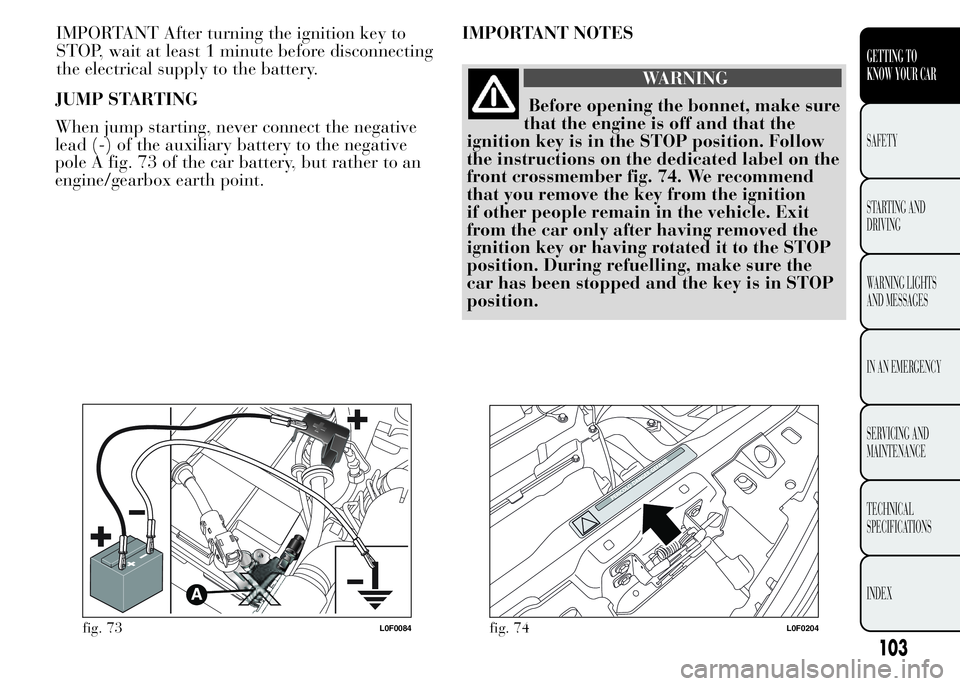
JUMP STARTING
When jump starting, never connect the negative
lead (-) of the auxiliary battery to the negative
pole A fig. 73 of the car battery, but rather to an
engine/gearbox earth point.IMPORTANT NOTES
WARNING
Before opening the bonnet, make sure
that the engine is off and that the
ignition key is in the STOP position. Follow
the instructions on the dedicated label on the
front crossmember fig. 74. We recommend
that you remove the key from the ignition
if other people remain in the vehicle. Exit
from the car only after having removed the
ignition key or having rotated it to the STOP
position. During refuelling, make sure the
car has been stopped and the key is in STOP
position.
fig. 73L0F0084fig. 74L0F0204
103
GETTING TO
KNOW YOUR CAR
SAFETY
STARTING AND
DRIVING
WARNING LIGHTS
AND MESSAGES
IN AN EMERGENCY
SERVICING AND
MAINTENANCE
TECHNICAL
SPECIFICATIONS
INDEX
IMPORTANT After turning the ignition key to
STOP, wait at least 1 minute before disconnecting
the electrical supply to the battery.
Page 108 of 315
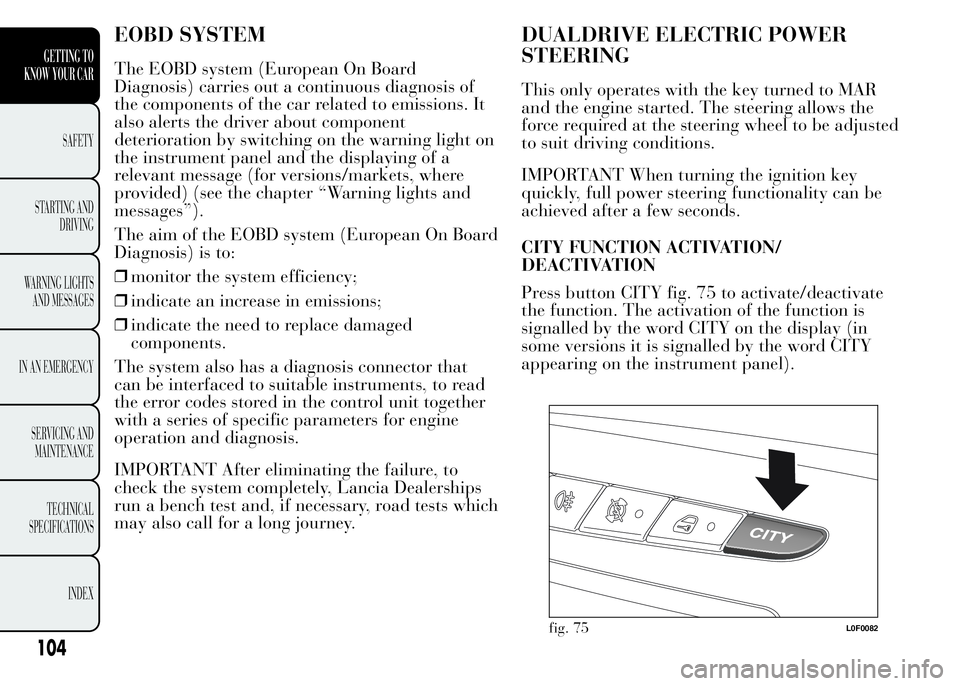
EOBD SYSTEM
The EOBD system (European On Board
Diagnosis) carries out a continuous diagnosis of
the components of the car related to emissions. It
also alerts the driver about component
deterioration by switching on the warning light on
the instrument panel and the displaying of a
relevant message (for versions/markets, where
provided) (see the chapter “Warning lights and
messages”).
The aim of the EOBD system (European On Board
Diagnosis) is to:
❒monitor the system efficiency;
❒indicate an increase in emissions;
❒indicate the need to replace damaged
components.
The system also has a diagnosis connector that
can be interfaced to suitable instruments, to read
the error codes stored in the control unit together
with a series of specific parameters for engine
operation and diagnosis.
IMPORTANT After eliminating the failure, to
check the system completely, Lancia Dealerships
run a bench test and, if necessary, road tests which
may also call for a long journey.
DUALDRIVE ELECTRIC POWER
STEERING
This only operates with the key turned to MAR
and the engine started. The steering allows the
force required at the steering wheel to be adjusted
to suit driving conditions.
IMPORTANT When turning the ignition key
quickly, full power steering functionality can be
achieved after a few seconds.
CITY FUNCTION ACTIVATION/
DEACTIVATION
Press button CITY fig. 75 to activate/deactivate
the function. The activation of the function is
signalled by the word CITY on the display (in
some versions it is signalled by the word CITY
appearing on the instrument panel).
fig. 75L0F0082
104
GETTING TO
KNOW YOUR CAR
SAFETY
STARTING AND
DRIVING
WARNING LIGHTS
AND MESSAGES
IN AN EMERGENCY
SERVICING AND
MAINTENANCE
TECHNICAL
SPECIFICATIONS
INDEX
Page 109 of 315
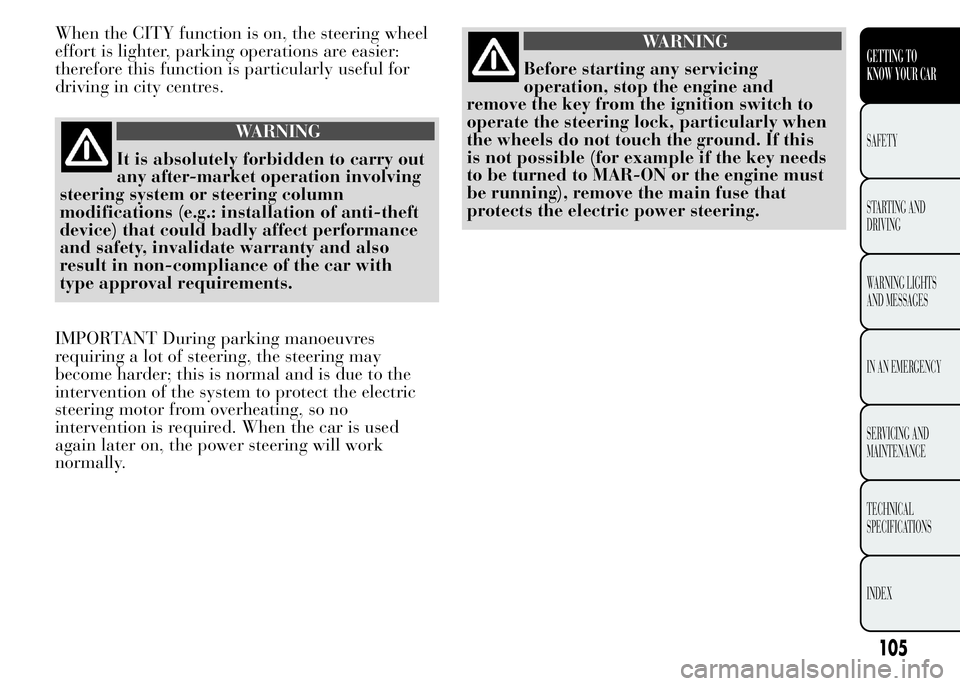
When the CITY function is on, the steering wheel
effort is lighter, parking operations are easier:
therefore this function is particularly useful for
driving in city centres.
WARNING
It is absolutely forbidden to carry out
any after-market operation involving
steering system or steering column
modifications (e.g.: installation of anti-theft
device) that could badly affect performance
and safety, invalidate warranty and also
result in non-compliance of the car with
type approval requirements.
IMPORTANT During parking manoeuvres
requiring a lot of steering, the steering may
become harder; this is normal and is due to the
intervention of the system to protect the electric
steering motor from overheating, so no
intervention is required. When the car is used
again later on, the power steering will work
normally.
WARNING
Before starting any servicing
operation, stop the engine and
remove the key from the ignition switch to
operate the steering lock, particularly when
the wheels do not touch the ground. If this
is not possible (for example if the key needs
to be turned to MAR-ON or the engine must
be running), remove the main fuse that
protects the electric power steering.
105
GETTING TO
KNOW YOUR CAR
SAFETY
STARTING AND
DRIVING
WARNING LIGHTS
AND MESSAGES
IN AN EMERGENCY
SERVICING AND
MAINTENANCE
TECHNICAL
SPECIFICATIONS
INDEX
Page 110 of 315
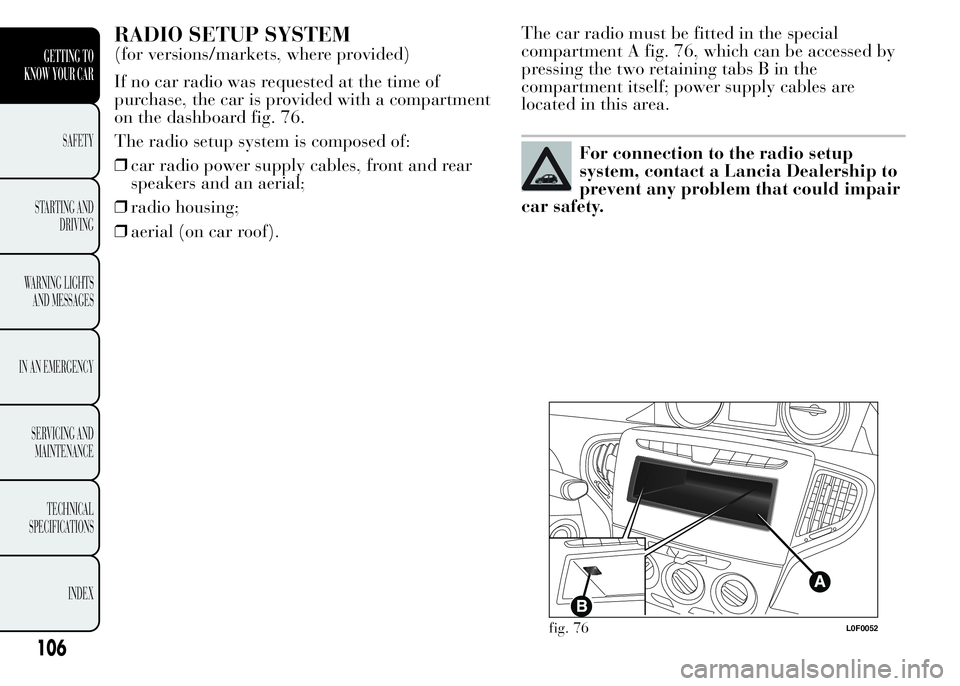
RADIO SETUP SYSTEM
(for versions/markets, where provided)
If no car radio was requested at the time of
purchase, the car is provided with a compartment
on the dashboard fig. 76.
The radio setup system is composed of:
❒car radio power supply cables, front and rear
speakers and an aerial;
❒radio housing;
❒aerial (on car roof).The car radio must be fitted in the special
compartment A fig. 76, which can be accessed by
pressing the two retaining tabs B in the
compartment itself; power supply cables are
located in this area.
For connection to the radio setup
system, contact a Lancia Dealership to
prevent any problem that could impair
car safety.
fig. 76L0F0052
106
GETTING TO
KNOW YOUR CAR
SAFETY
STARTING AND
DRIVING
WARNING LIGHTS
AND MESSAGES
IN AN EMERGENCY
SERVICING AND
MAINTENANCE
TECHNICAL
SPECIFICATIONS
INDEX
Page 111 of 315

PREPARATION TO INSTALL A
PORTABLE NAVIGATION SYSTEM
On cars equipped with the Blue&MeTMsystem,
there may be (on request) the set-up for installing
the Blue&Me
TMTomTom®portable navigation
system, available from Lineaccessori Lancia.
Install the portable navigation system by fitting
the relevant supporting bracket in the housing
shown in fig. 77.
INSTALLING ELECTRICAL/
ELECTRONIC DEVICES
INSTALLING ELECTRICAL/ELECTRONIC
DEVICES
Electrical and electronic devices installed after
buying the car in the context of after-sales service
must carry the label (see fig. 78).
Fiat S.p.A. authorises the installation of
transceivers provided that installation is carried
out at a specialised centre, in a workmanlike
fashion and in compliance with manufacturer's
specifications.
IMPORTANT Traffic police may not allow the car
on the road if devices have been installed which
modify the features of the car. This may also cause
invalidation of warranty in relation to faults
caused by the change either directly or indirectly
related to it.
FIAT S.p.A. shall not be liable for damage caused
by the installation of accessories either not
supplied or recommended by FIAT S.p.A. and/or
not installed in compliance with the provided
instructions.
fig. 77L0F0164fig. 78DISPOSITIVI-ELETTRONICI
107
GETTING TO
KNOW YOUR CAR
SAFETY
STARTING AND
DRIVING
WARNING LIGHTS
AND MESSAGES
IN AN EMERGENCY
SERVICING AND
MAINTENANCE
TECHNICAL
SPECIFICATIONS
INDEX
Page 112 of 315

RADIO TRANSMITTERS AND CELLULAR
PHONES
Radio transmitter equipment (vehicle mobile
phones, CB radios, amateur radio etc.) cannot be
used inside the car unless a separate aerial is
mounted externally.
IMPORTANT The use of these devices inside the
passenger compartment (without an external
aerial) may cause the electrical systems to
malfunction. This could compromise the safety of
the car in addition to constituting a potential
hazard for passengers' health.
In addition, transmission and reception of these
devices may be affected by the shielding effect of
the car body. As far as the use of EC-approved
mobile phones is concerned (GSM, GPRS, UMTS),
follow the usage instructions provided by the
mobile phone manufacturer.PARKING SENSORS
(for versions/markets, where provided)
The parking sensors are located in the car's rear
bumper fig. 79 and their function is to inform the
driver, through an intermittent acoustic signal,
about the presence of obstacles behind the car.
ACTIVATION/DEACTIVATION
The sensors are automatically activated when
reverse gear is engaged. As the obstacle behind the
vehicle gets closer to the car, the acoustic signal
becomes more frequent.
ACOUSTIC SIGNAL
When reverse gear is engaged and there is an
obstacle behind the car an acoustic signal is
activated which varies according to the distance of
the obstacle from the bumper.
LANCIA
fig. 79L0F0027
108
GETTING TO
KNOW YOUR CAR
SAFETY
STARTING AND
DRIVING
WARNING LIGHTS
AND MESSAGES
IN AN EMERGENCY
SERVICING AND
MAINTENANCE
TECHNICAL
SPECIFICATIONS
INDEX
Page 113 of 315

The frequency of the acoustic signal:
❒increases as the distance between the car and
the obstacle decreases;
❒becomes continuous when the distance between
the car and the obstacle is less than 30 cm and
stops immediately if the distance increases;
❒is constant if the distance is unchanged.
If several obstacles are detected by the sensors,
only the nearest one is considered.
FAULT INDICATION
Any parking sensor faults will be indicated when
reverse is engaged by the
warning light on
the instrument panel together with the message in
the multifunction display (for versions/markets,
where provided) (see “Warning lights and
messages” section).OPERATION WITH TRAILER
Sensor operation is deactivated automatically
when the trailer's electric cable plug is fitted into
the car's tow hook socket.
The sensors are automatically reactivated when
the trailer's cable plug is removed.
For correct operation, sensors must
always be clean from mud, dirt, snow
or ice. Be careful not to scratch or
damage the sensors while cleaning them.
Avoid using dry, rough or hard cloths. The
sensors must be washed using clean water,
with the addition of car shampoo if necessary.
When using special washing equipment such
as high pressure jets or steam cleaning, clean
the sensors very quickly keeping the jet more
than 10 cm away.
109
GETTING TO
KNOW YOUR CAR
SAFETY
STARTING AND
DRIVING
WARNING LIGHTS
AND MESSAGES
IN AN EMERGENCY
SERVICING AND
MAINTENANCE
TECHNICAL
SPECIFICATIONS
INDEX
Page 114 of 315

❒the signals sent by the sensor can also be altered
by the presence of ultrasonic systems (e.g.
pneumatic brake systems of trucks or
pneumatic drills) near the vehicle;
❒parking assistance system performance can also
be influenced by the position of the sensors, for
example due to a change in the ride setting
(caused by wear to the shock absorbers,
suspension), or by changing tyres, overloading
the car or carrying out specific tuning
operations that require the car to be lowered.
WARNING
The driver is always responsible for
parking manoeuvres however. When
making these manoeuvres, always make sure
that no people (especially children) or
animals are present in your manoeuvring
area. The parking sensors are an aid for the
driver, but must never allow their attention
to lapse during potentially dangerous
manoeuvres, even those executed at low
speeds.
110
GETTING TO
KNOW YOUR CAR
SAFETY
STARTING AND
DRIVING
WARNING LIGHTS
AND MESSAGES
IN AN EMERGENCY
SERVICING AND
MAINTENANCE
TECHNICAL
SPECIFICATIONS
INDEX
GENERAL WARNINGS
❒When parking, take the utmost care over
obstacles that may be above or under the
sensors.
❒Objects close to the car, are not detected under
certain circumstances and could therefore cause
damage to the car or be damaged.
The following conditions may influence the
performance of the parking sensor system:
❒reduced sensor sensitivity and a reduction in the
parking assistance system performance could be
due to the presence on the surface of the sensor
of: ice, snow, mud, thick paint;
❒the sensor may detect a non-existent obstacle
(echo interference) due to mechanical
interference, for example when washing the car,
in rain (strong wind), hail;
Page 115 of 315
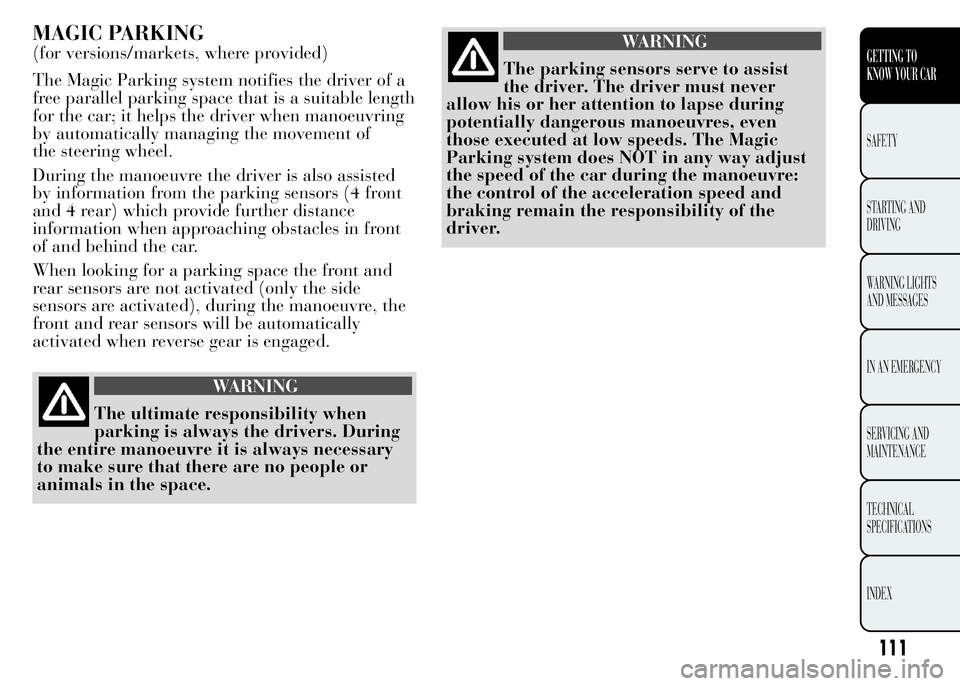
WARNING
The parking sensors serve to assist
the driver. The driver must never
allow his or her attention to lapse during
potentially dangerous manoeuvres, even
those executed at low speeds. The Magic
Parking system does NOT in any way adjust
the speed of the car during the manoeuvre:
the control of the acceleration speed and
braking remain the responsibility of the
driver.
111
GETTING TO
KNOW YOUR CAR
SAFETY
STARTING AND
DRIVING
WARNING LIGHTS
AND MESSAGES
IN AN EMERGENCY
SERVICING AND
MAINTENANCE
TECHNICAL
SPECIFICATIONS
INDEX
MAGIC PARKING
(for versions/markets, where provided)
The Magic Parking system notifies the driver of a
free parallel parking space that is a suitable length
for the car; it helps the driver when manoeuvring
by automatically managing the movement of
the steering wheel.
During the manoeuvre the driver is also assisted
by information from the parking sensors (4 front
and 4 rear) which provide further distance
information when approaching obstacles in front
of and behind the car.
When looking for a parking space the front and
rear sensors are not activated (only the side
sensors are activated), during the manoeuvre, the
front and rear sensors will be automatically
activated when reverse gear is engaged.
WARNING
The ultimate responsibility when
parking is always the drivers. During
the entire manoeuvre it is always necessary
to make sure that there are no people or
animals in the space.